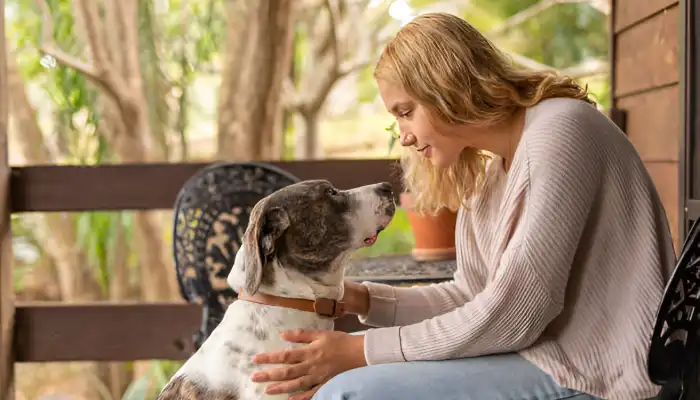How do you tell a dog you’re sorry? Admittedly a strange question, but one every dog owner has asked. weather you’ve comedically stubbed your toe on their paw, raised your volume a tad too much, or simply forgot to take them out for a walk – your charming little buddy knows something is amiss.
While dogs do not talk in an anthropomorphic tongue, they have their own methods of comprehending emotions. For the purpose of this blog, we will discuss how to do a doggy reconciliation without any futuristic dog translators.

Understanding How Dogs Communicate
Now, prior to exploring ways of saying “sorry” to your dog, let us explain how they converse. Dogs understand social cues such as gestures, voice inflections, and even scents. They detect the slightest traces of emotion that hint whether you’re angry, disappointed, or in fact apologetic.
Hence, in regard to the presented query on how to say sorry to a canine: you don’t really need to be worried about the words. Rather, your focus should be directed towards the manner in which you express your apology.
Non-verbal Cues: The Key to Apology
Apologizing for something you did to a dog can be challenging as they do not use the same language as you do, therefore you need to rely solely on non-verbal options. Here is how do you tell a dog you’re sorry without uttering a single word.
- Calm Body Expressions: When approaching a dog after they have done something wrong, it is critical to soften your expression. It is best to consider portraying a calm and positive outlook.
- Tender Hand Movements: Dogs often associate light strokes or rubs with affection, so this is a great way to let them know that their well-being is not in question.
- Crouch Down: Often, a dog will feel more accepting and comfortable when their owner is at eye level; therefore it is good to squat or kneel to let them come closer to face you.
- Gentle Words: Dogs may not understand the contents of speech, but they do understand the tone. To prevent scaring them away, a slow and vocalized caring tone should be used.
With careful analysis of the way dogs convey messages, it makes it easier to open up while making sure they understand your true intention. Let us not forget that it is not only about stating what they want to hear, but having the willingness to express love.
Behavioral Apology: Showing You Care
An apology may be needed with a dog, and it may not always be as simple as saying “sorry.” Here is how do you tell a dog you’re sorry with actions instead of words.
- Spend More Time With Them: Try to set aside extra time to go for more walks as well as playing their favorite games.
- Give Them Something Extra: Show them you care by giving a little extra in terms of their special treat. Pavlov’s can come running as soon as their bowl is put down because dogs quickly associate positive experiences with apologies.
- Change their surroundings for the better: A less comfortable and unfamiliar environment would be hard for them to relax in so making it comfortable automatically makes it easier for a dog to destress.
Apologies can be shown through thoughtful actions like making their space comfortable or treating them with accomplishments. These gestures help reinforce and heal the relationship.
Apologizing Through Trust-Building Activities
Apologies can also be shown through better trust building exercises once bond is already formed with them. Dogs like other pets are loyal, but they must feel safe in their surroundings first. Important exercises for basic obedience do the trick for building better bonds and trust among other themes too.
- Using Commands to Show them What’s Right and What’s Wrong: Trying out some off-leash or basic obedience training exercises can help them remember the bond you share and help rebuild the trust that accompanies it.
- Interactive Play: Get outside and do something fun like fetch or tug of war. This will help get you back on friendly terms.
- Calm and Relaxing Time Together: Sometime sitting on the couch doing nothing can be the best way to saying sorry. Dogs enjoy and love staying close to their owner, and a bit of quiet time can help assuage anger.
Trust-building activities can help fix any damage done and strengthen your bond with your dog. Having positive interactions with them will reinforce your dog’s knowledge of your love and commitment.
How To Tell a Dog You’re Sorry?
After knowing how to send your dog messages without words, you might ask: How do you tell a dog you’re sorry? Dogs do not possess time as a concept. The only thing you need to know is what you do after an apology matters most. With a little love and attention on repeat, your dog will know he is safe to be loved.
The Function of a Dog Translator in An Apology
A dog translator could be captivating from the perspectiveof how dogs think a human’s attempt is performed, as words and emotions could be very different in the eyes of a canine. While no true ‘dog translator’ exist, people usually understand behavior and gestures of other people, which, in turn, could aid as a guide. When you understand their signals, you can convey your feelings of sorrow and help them the way they need comfort.
A type of dog translator might not exist, but relating to them through their actions and behavior is the way to go. Since there is a possibility of knowing the dog, it is also possible to express love and remorse in the most effective way.
Conclusion
In summary, How do you tell a dog you’re sorry? It is about their manner of communication and emotion at the same time. Dogs have an enormous sense of feeling and they always believe in truthfulness. It does not matter if your apologies come in form of touching, spending time together, or playing, your dog would see the intention. Just note that they forgive at the snap of a finger, meaning both of you will be back to your happy selves in no time.
In the end, the solution to “How do you tell a dog you’re sorry?” lies in how you act. You can strengthen your relationship and express remorse with your dog through love, care, and understanding.
